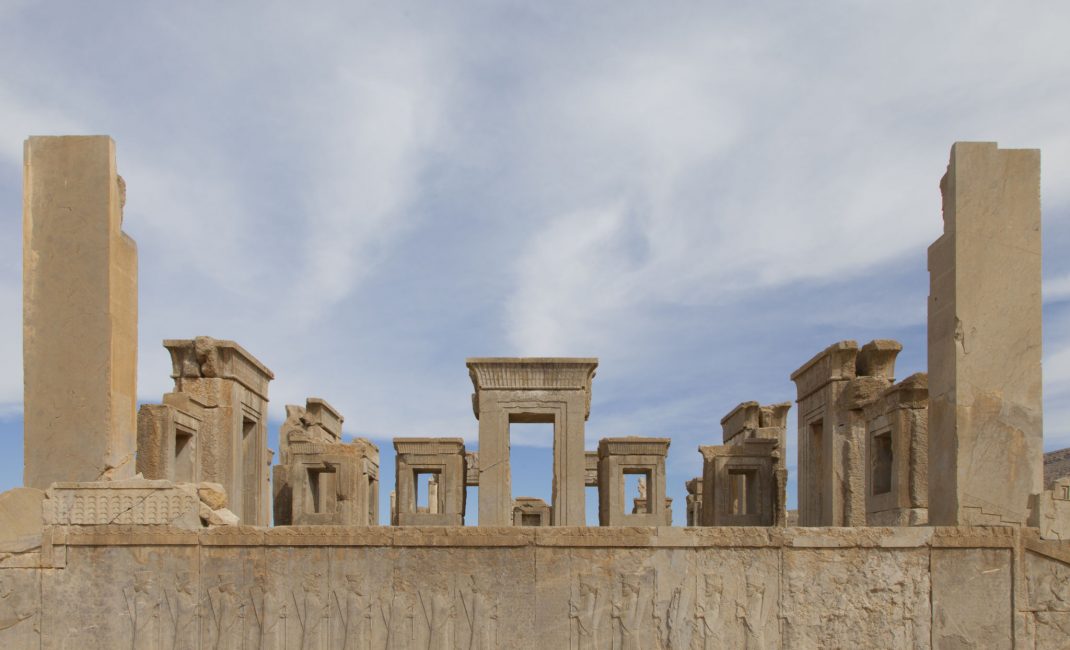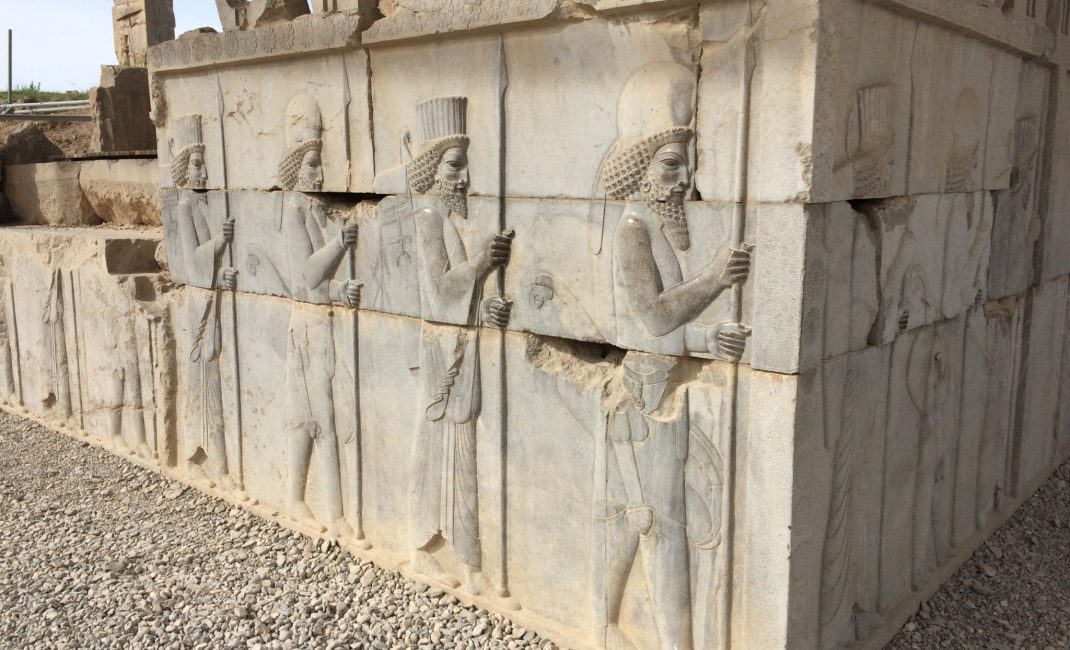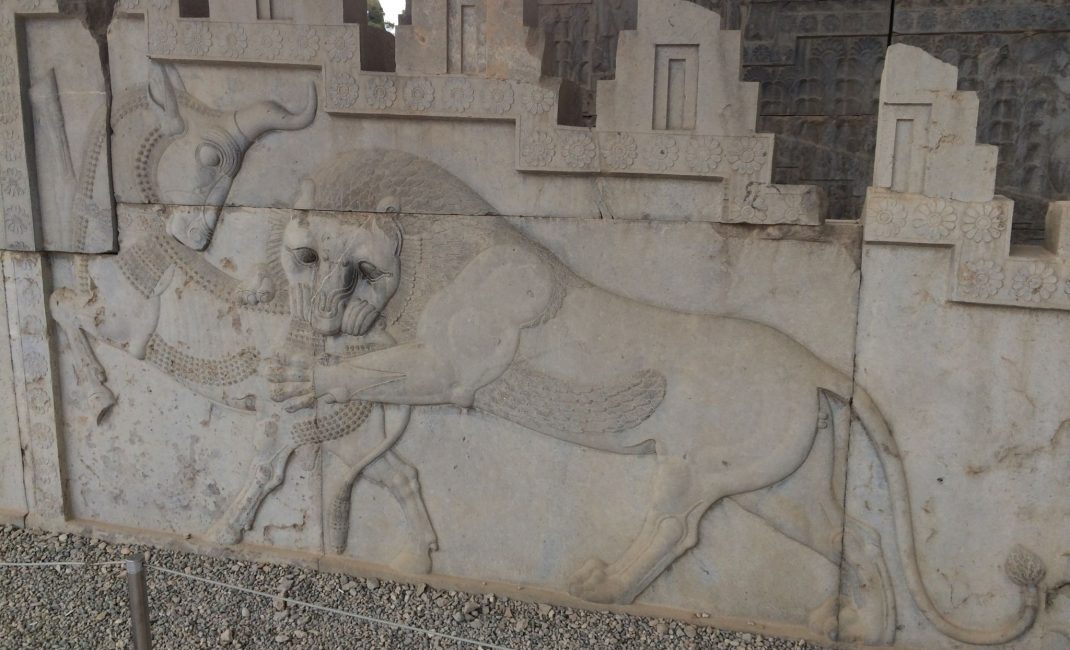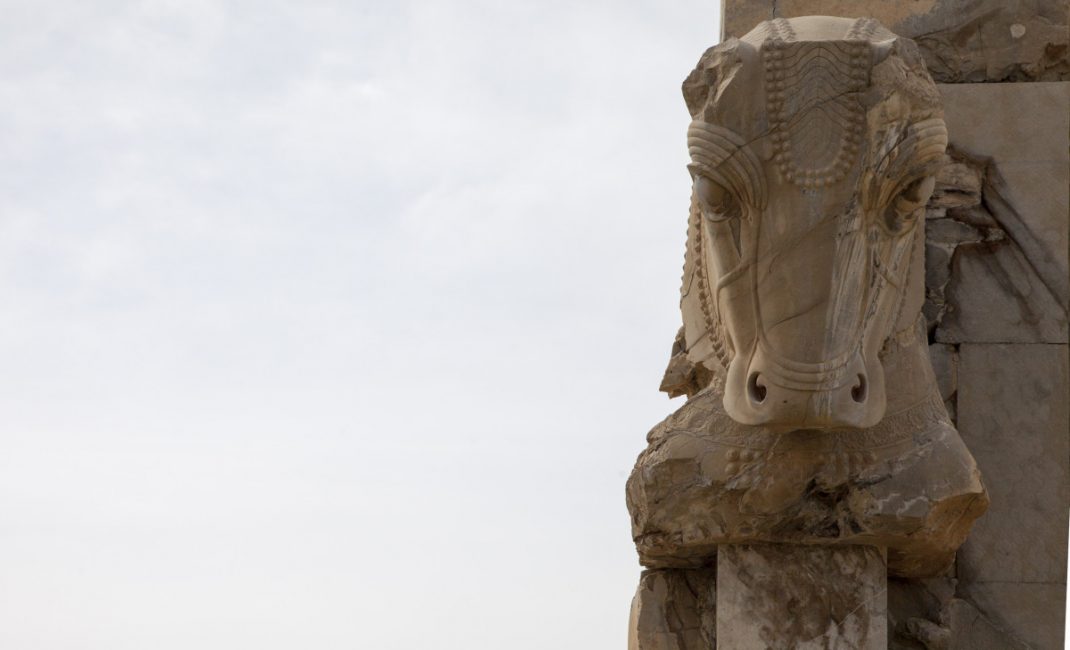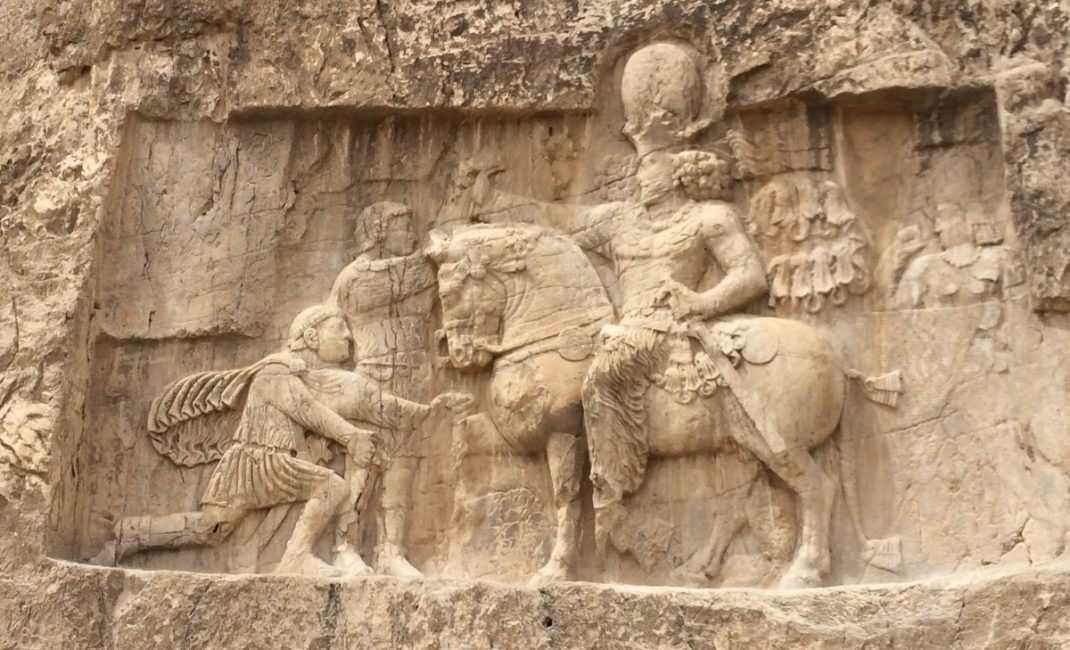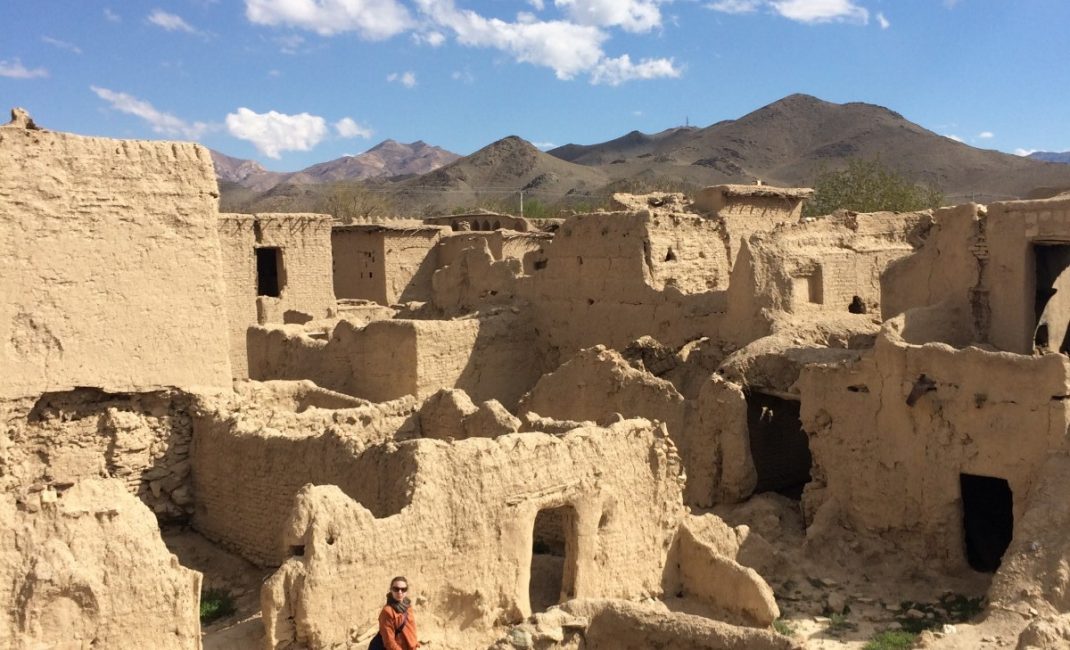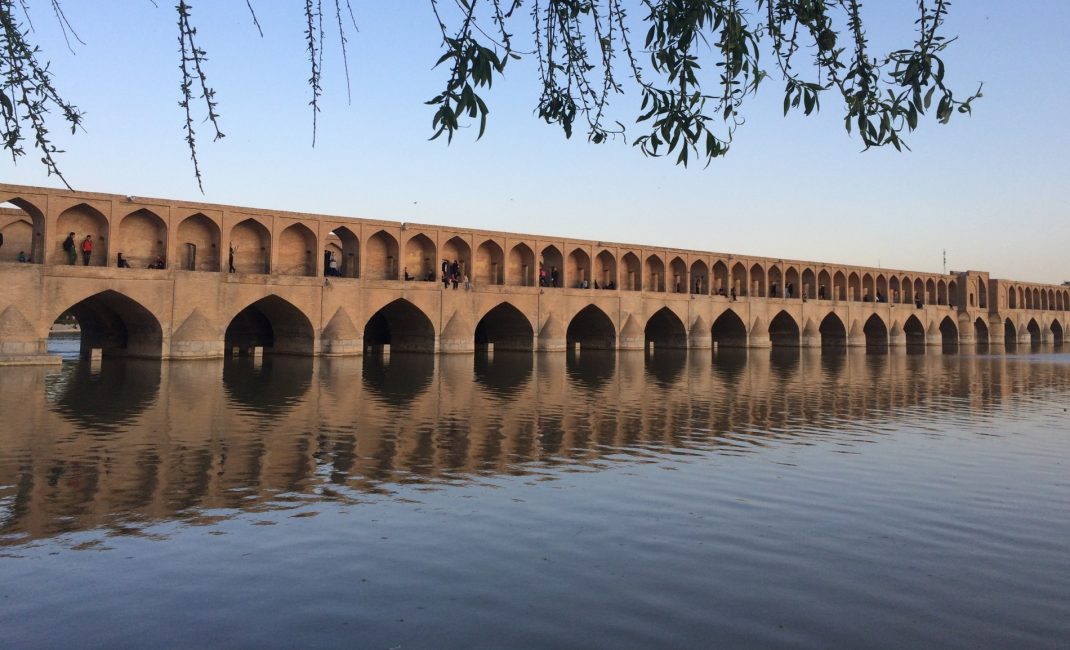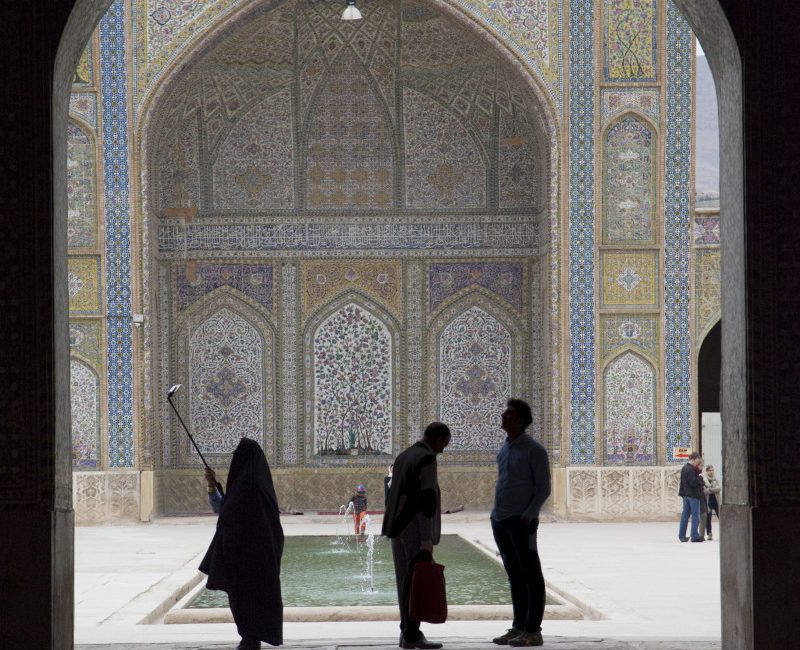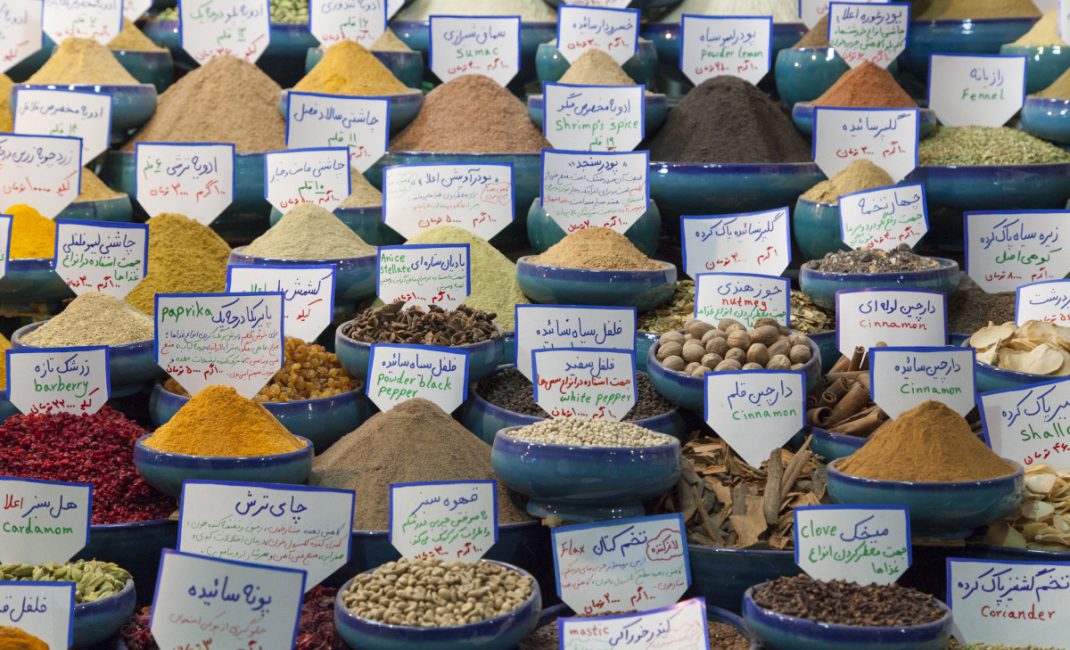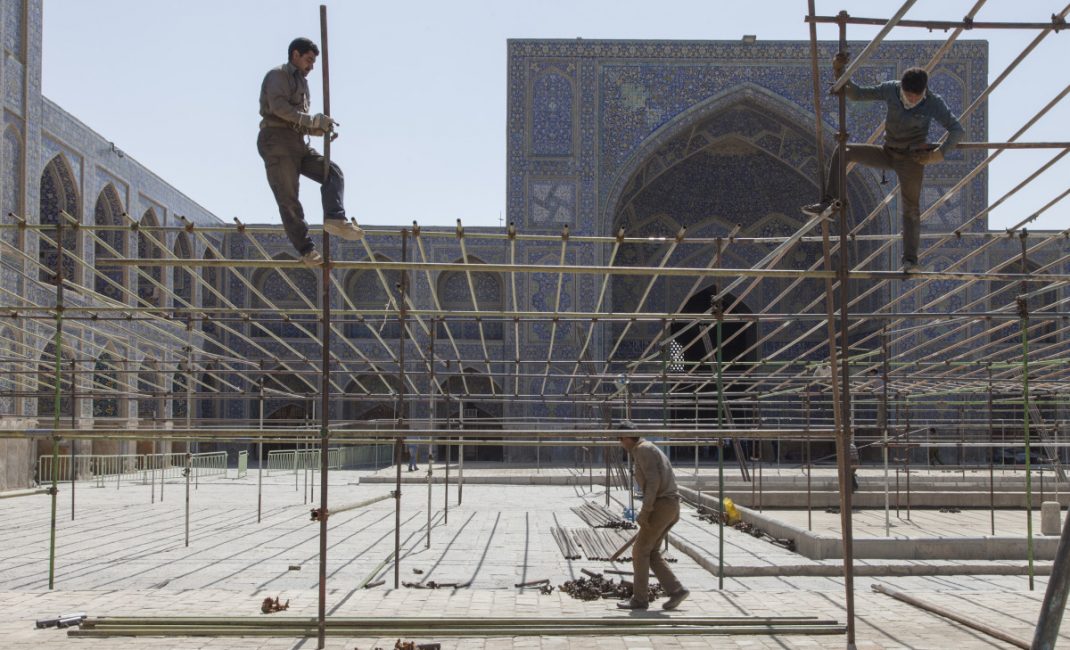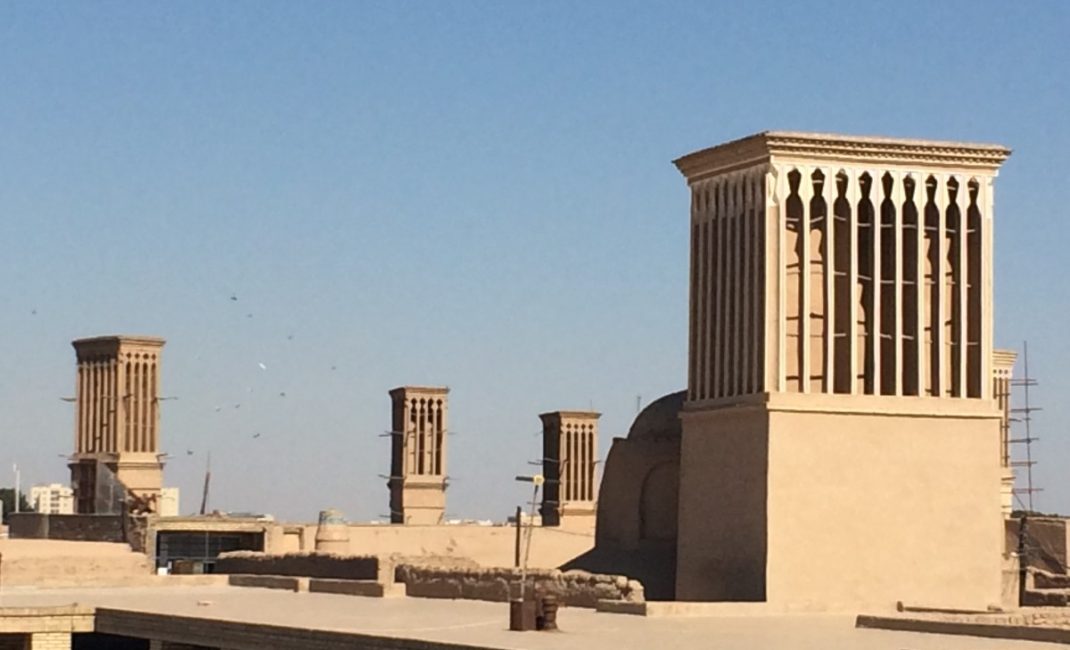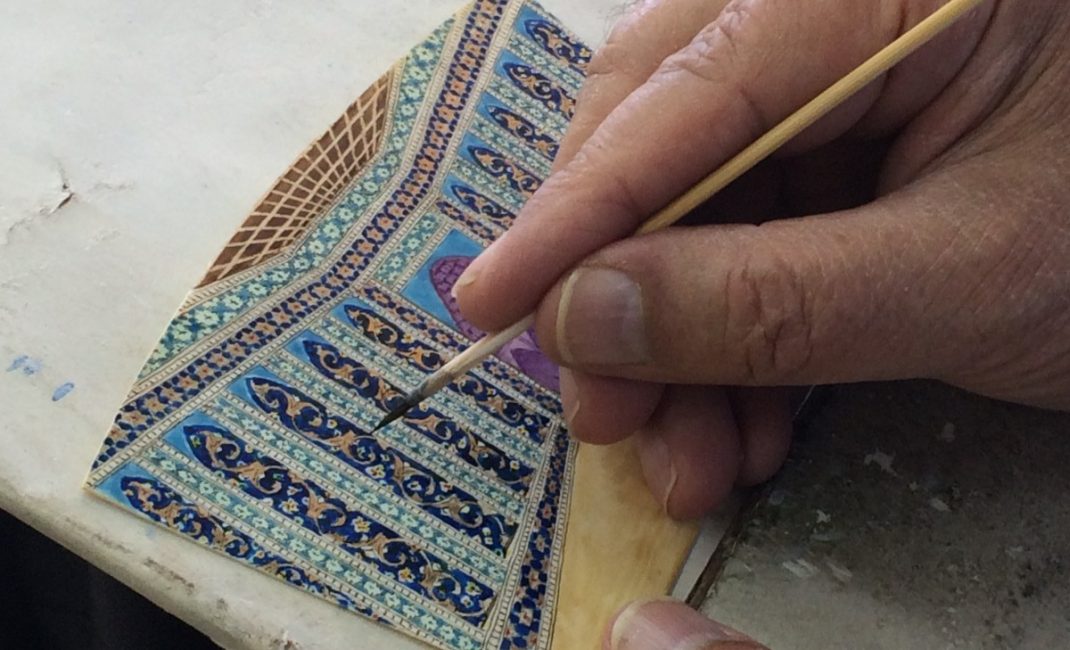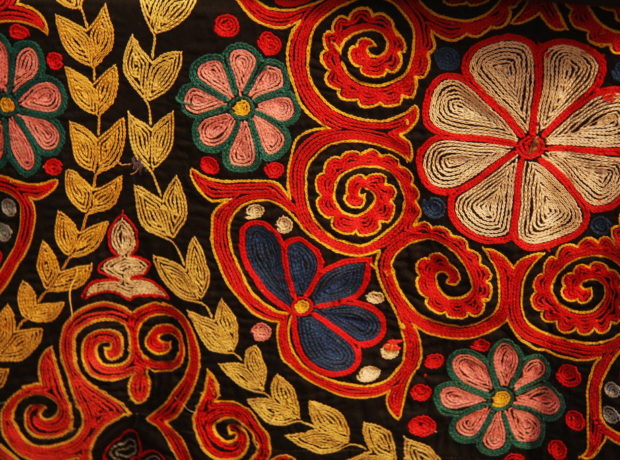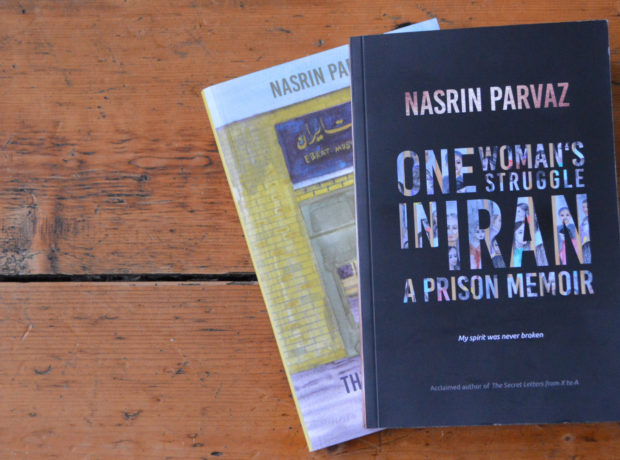In spring 2016, just a few months after the international sanctions on Iran were partly lifted, Sophia Insoll and a small group of friends organised a trip to Tehran, Isfahan, Shiraz and Yazd, visiting cities, archaeological sites, places of natural interest and religious architecture and shrines. In her travel scrapbook she pieces together impressions of her journey and wonders what she really knows about the country.
Huddled in the back of a public minibus, squeezed between a screaming child and a scolding granny, I watched as a young woman wearing hijab flirted with one of my European friends. Phone numbers were exchanged in the space of a five minute journey. Someone landed a date on the first day in Iran. This was the first of many unexpected events in a country full of surprises and contradictions.
Why Iran?
There were plenty of reasons why I chose to go to Iran. A country of nearly 80 million people, Iran has an impressive history and its tourist attractions and cultural offering reflect that heritage. Travellers have long marvelled at the majesty of Persepolis, capital of the Achaemenid Empire dating back to the 6th Century BC, the exquisite decorative tiling of the Sheikh Lotfollah Mosque in Isfahan completed in the early 1600s, and the luxury of the last Shah’s palaces.
Fourteenth century poet Hafez is revered as literary icon at home and abroad, and the genius and humour of novelist Iraj Pezeshkzad, author of the popular family saga My dear uncle Napoleon, and cartoonist Marjane Satrapi who reached fame with her graphic novel Persepolis are internationally acclaimed. Iran has also given us Nobel Peace Prize winner Shirin Ebadi, a lawyer, feminist and human rights advocate whose writing and talks inspired my own professional aspirations.
Friends and acquaintances who have lived in the country at various points from the Sixties onwards – and others who have never set foot in their ancestral homeland but live and breathe their heritage elsewhere in the world – have painted Iran’s history and society to me in broad strokes. The country and its people have suffered. That much is undisputed. The violent authoritarianism of the Shah, followed by the repressive regime that took power in 1979 and the subsequent international sanctions, have cast a shadow over the lives of ordinary people. Historic and contemporary persecutions and discrimination of ethnic and religious minorities have decimated communities such as the Zoroastrians (known as Parsi in India) and the Baha’i.
More recently, public perceptions of Iran in the political west took a turn for the worst when George W. Bush listed the country among the ‘axis of evil’, with severe consequences in international politics and trade relations. This succession of events has resulted in a vast and multifaceted Iranian diaspora. And yet, over the past decades Iran has become a destination of hope for millions of migrants fleeing war-torn neighbouring countries – including Iraqis and an estimated five million Afghans – adding new responsibilities to its complex reality.
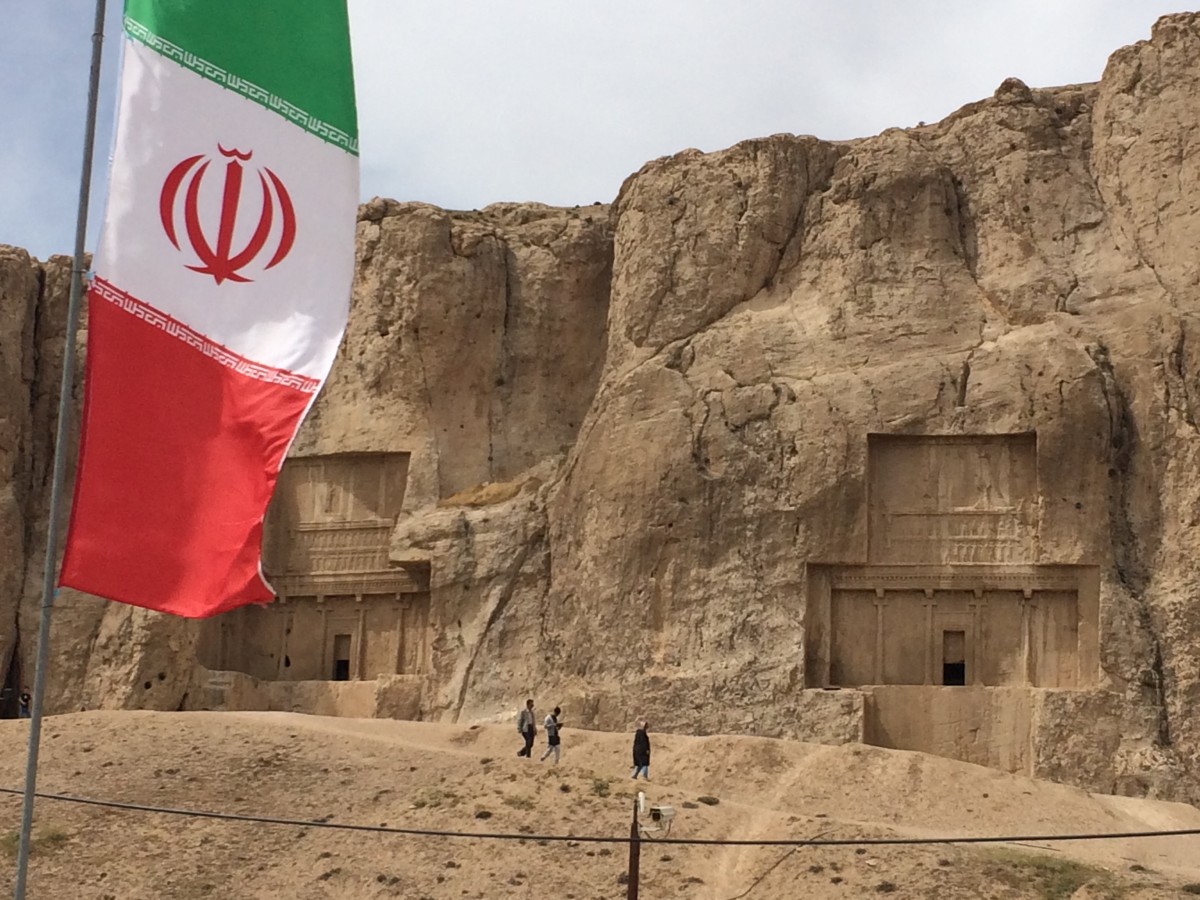
Naqsh Rostam. Photo by Chiara Ferroni.
Some things, though, have been changing recently. On 16th January 2016, Iranian Foreign Minister Javad Zarif tweeted in celebration of #implementationday, the moment in which the international sanctions on Iran officially ended when the UN International Atomic Energy Agency announced its satisfaction at Iran’s compliance with the nuclear deal. The Council of the European Union formally lifted all nuclear-related economic and financial sanctions that day and a clear political will for EU/Iran cooperation has developed.
All this history and recent political changes were encouragement enough to go and see for myself.
Queuing for my visa on arrival at Imam Khomeini airport I expected to be greeted with stern formality. The border officials would bark at me to elicit information about who I was and what I was doing there, and try to catch me off guard, though I had nothing to hide or fear. What if I was refused entry? What if all my fears and preconceptions of an authoritarian regime were proven correct, and something awful happened? But I saw no heavily armed border force like at Heathrow, no sniffer dogs like at Malpensa, no fingerprinting like at JFK. And after a short wait and limited paperwork, an official said to me: ‘Welcome to Iran, enjoy your stay’. The only hint of walking into an authoritarian state was the sign hanging from the wall warning travellers, in English, that criticising the authorities is a criminal offence.
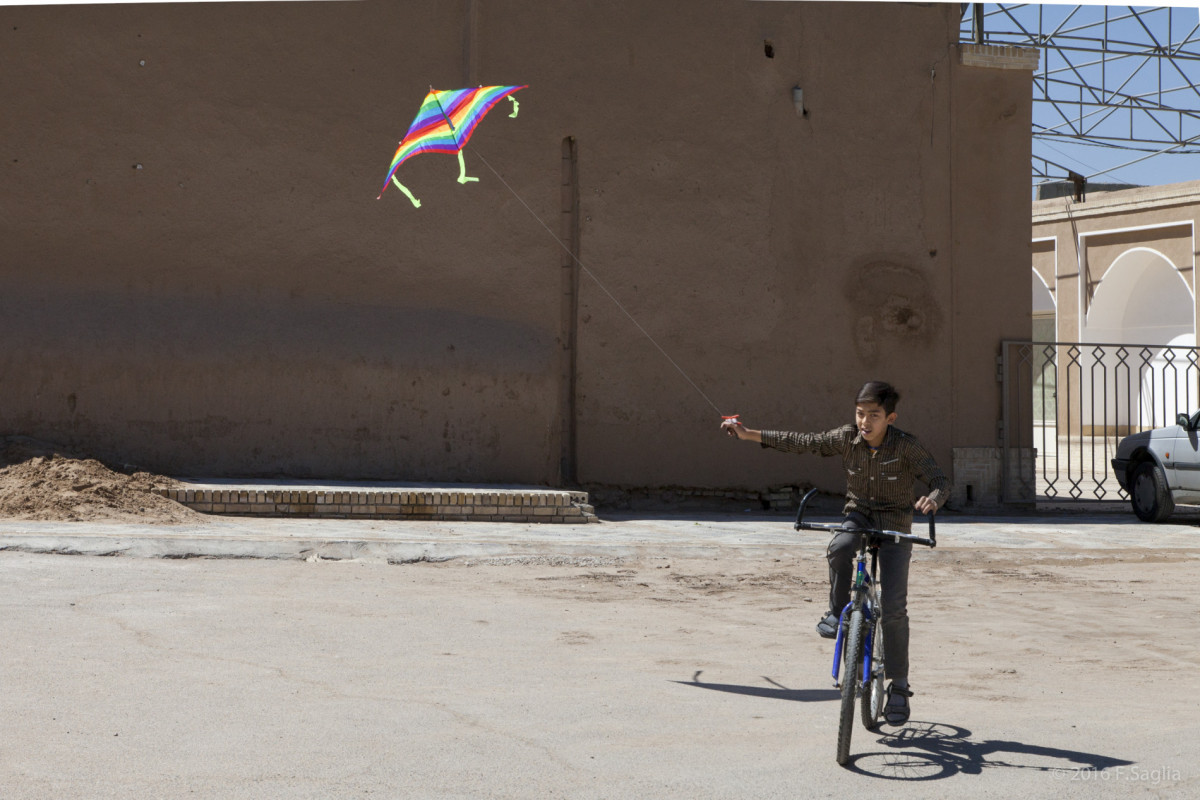
Boy in Yazd. Photo by Fabrizio Saglia.
Good hijab, Bad hijab
The first thing I got wrong was my attire. Female travellers conscious of gender dynamics on the streets quickly learn to cover up whenever unsure of social codes. Stories I had read online, reports from Persian friends reprimanded by the morality police in their youth, and personal experiences elsewhere in the Middle East persuaded me to invest in what can be described as a portable terracotta-coloured tent. I carefully chose a textured silk scarf that would not require constant readjustment. The picture of modesty, yet in a stylish spring/summer 2016 hue. To the world around me, a walking orange tent.
So I found myself rather out of place sipping London-priced lattes in a northern Tehran café, among the glamour of oversized shades and bespoke jewellery. Even in less affluent parts of the capital I felt I had interpreted modesty requirements a little too literally. All around me at the Film Museum gardens headscarves were perched loosely over ponytails, constantly falling off and being readjusted, with nobody taking much notice at all. As I queued for a ticket to the Golestan Palace a woman my age started chatting about the hijab. ‘Do you like it?’ she asked, using a google translate app on her smartphone.
‘It doesn’t really bother me, it’s just like a hat’ I retorted.
She then pulled a face and indicated I should pull it back to show more hair, and pointed at her symbolic head covering. ‘Like me’. And before too long, her hands took hold of my scarf, and I got a makeover. The warmth of that moment reminded me of why I travel.
Gradually, I found my bearings and emerged from under my terracotta tent in jeans and a waterfall cardigan.
On the streets I spotted many local women sporting leggings and long-ish tops happily alongside government employees whose dress-code is a black cape over any chosen outfit, sometimes revealing a flash of colour underneath. Variety, as ever, ruled the catwalk between the underground escalators, kebab stalls and upmarket restaurants.
While paying lip service to the state-enforced dress codes, for what I saw, Tehranis struck me as a liberal, dynamic and buzzing society, where bending the good hijab rules is a subtle way to mock distant conservative rulers. The current political establishment, an Iranian friend back home once said, is too busy maintaining a grip on a country always on the verge of revolution to worry too much about slipping hijabs. But as I walked around the capital, it felt to me that the real disinterest flowed in the opposite direction: many Iranians didn’t seem too bothered about pleasing those in power, let alone by conforming to the dress codes.
Politics and Power
The second thing I got wrong was the attitude towards politics among those I met throughout the trip. Well-aware of the strictures of an authoritarian state, I presumed nobody would be willing to discuss domestic affairs or regional geopolitics. I was naive.
Sipping the ubiquitous Lavazza espresso in a courtyard just off the spectacular main square in Isfahan, a young Iranian man complained about mandatory military service. ‘I was lucky’ he said, ‘I spent two years playing volleyball in Tehran. Some people just sit around in the desert or worse still, are put on border duty with Pakistan’. I didn’t ask why that would have been his least favourite option, but I did google it when I got back home. That search produced a long list of news items from the region, very rarely covered in the British media, on the tensions between the two countries’ official forces and other armed groups that bleed into the local communities on both sides.

Chehel Sotoun, Isfahan. Photo by Fabrizio Saglia.
In a café in Shiraz, a baroque-inspired villa overlooking manicured gardens, another young man brought up daesh, the derogatory term adopted across Muslim-majority societies to refer to the self-styled Islamic state headquarted in Raqqa.
‘Do you know what they do to us Shias?’ he asked me. I waited for his response. ‘They are slaughtered as infidels’. And he told me of the death of his brother in the Iran-Iraq war, and the bittersweet consolation of being related to a martyr. I got a sense of the emotional trauma that might affect thousands more, and perhaps the entire nation dragged into a senseless conflict that claimed more than a million lives. So I respectfully said nothing and touched his arm as a gesture of sympathy. Had I been in a different environment, I would have offered a hug.
The conversation swiftly turned to the broader regional tensions. ‘If you find Iran safe, it is because there is no terrorism, no daesh here. We told Saudi Arabia that if just one incident of terrorism happens in Iran we will bomb Riyadh. Which is why you will be safer here than in Europe.’
He possibly had a point. I did not experience a sense of insecurity at any time throughout my stay, but then I’m not a member of the persecuted human rights community in Iran.
I turned to my new friend again. ‘You see’ he continued, ‘daesh exist because Saudi and Israel put them there’. Was this a common belief? Would I find that line of analysis in the local media? As I do not read Farsi, I could only guess what the official line may be by reading the state-owned English language Press TV targeting international audiences.
But a secure society – which was what I experienced during my short stay as a tourist – is not necessarily a rights-respecting one. In an open letter of 17th March 2016 a group of international human rights NGOs urged the members of the UN Human Rights Council to renew the mandate of the Special Rapporteur on the situation of human rights in the Islamic Republic of Iran. Concerns included a liberal application of the death penalty, also for vaguely-worded crimes such as ‘spreading corruption on earth’ and ‘insulting the prophet’, the persecution of human rights defenders, limited press freedom, and a climate of intolerance towards free speech, assembly and association, as well as severely inadequate trial standards, custody conditions and frequent recourse to torture and ill-treatment by law enforcement agents.
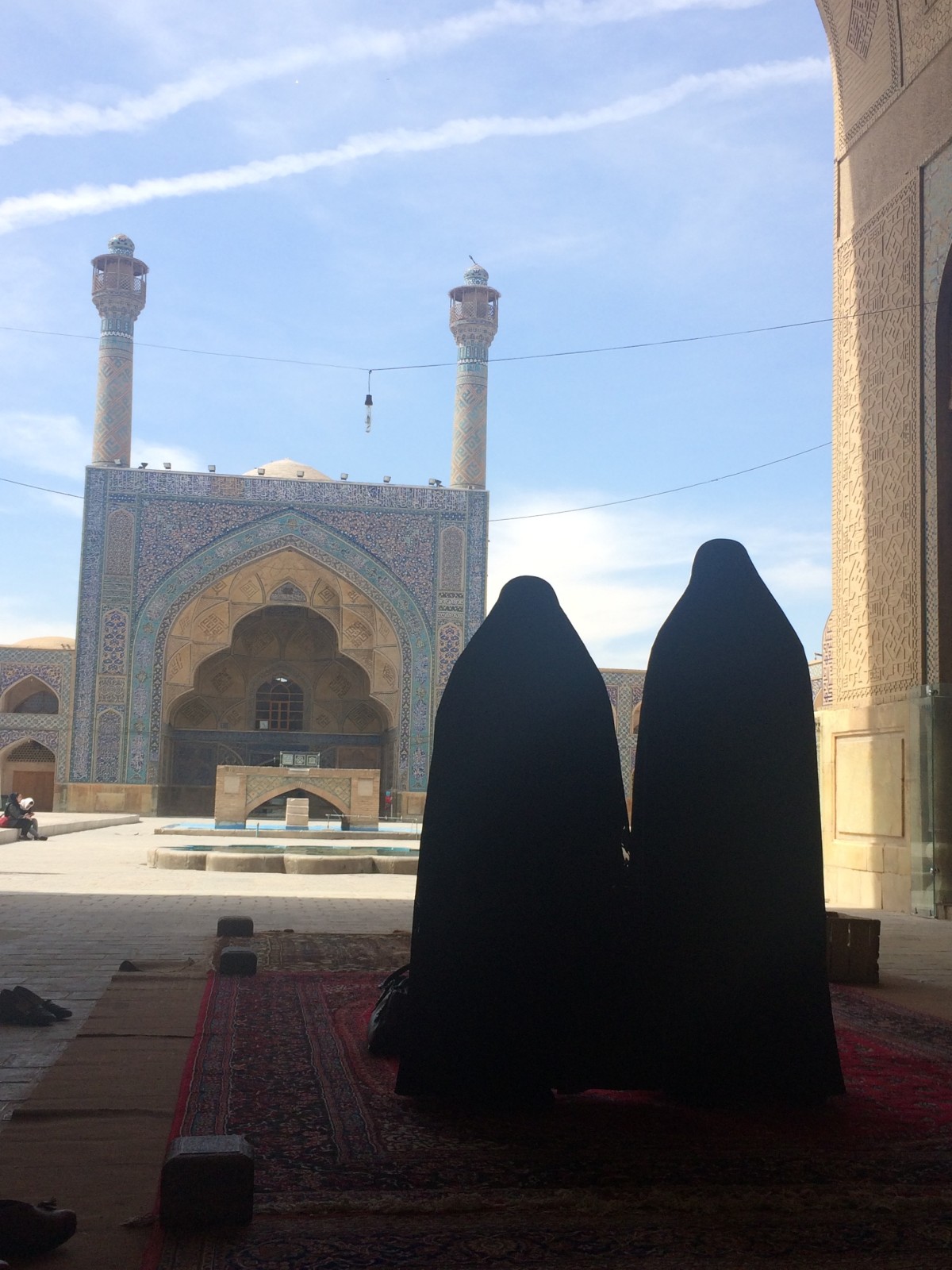
Jame Mosque, Isfahan. Photo by Chiara Ferroni.
The open letter was particularly critical of the dire state of women’s rights in Iran. Systematic discrimination and violence against women and girls, including domestic violence, marital rape, and early and forced marriage (40,404 girls between the ages of 10 and 14 married in 2014/2015) are rife.
The Iranian Parliament is also considering controversial draft bills that will further erode women’s rights, such as the Bill to Increase Fertility Rates and Prevent Population Decline and the Comprehensive Population and Exaltation of Family Bill, which would block access to information about contraception and outlaw vasectomies and tubectomies, and require all private and public employers to discriminate on the basis of gender, marital, and parental status in recruitment, prioritising married men with children over all other groups.
A further problem identified by human rights observers is the structural marginalisation and discrimination against non Shia Muslim minorities such as Ahwazi Arabs, Azerbaijani Turks, Balochis, Kurds and Turkmen, as well as non-Shia religious groups, including Sunni Muslims and Baha’is, as well as Shia-heritage converts to other faiths. I wondered if members of these communities would feel as safe as I did walking around town.
And only a few weeks ago the UN General Assembly published a report on the Situation of human rights in the Islamic Republic of Iran, which reads as an anthology of the worst abuses a government can inflict on its population, including capital punishment for minors, the widespread practice of torture in jail and police detention – especially harsh for political prisoners – and the furious crackdown on freedom of expression. Even academics, such as anthropology Professor Homa Hoodfar detained in the infamous Evin prison that became synonymous with torture during the violent repression of the 2009 protests, are unable to conduct their research freely in Iran. Yes Iran is safe, if you bow your head to power. But for as long as diversity and dissent are targeted and silenced, the safety I experienced will have a bitter aftertaste.
Faiths and fortunes
Contrary to popular belief, Iran did not strike me as a particularly Islamic nation compared to other parts of the Middle East I have seen. Chatting to a woman my mother’s age in English, an arty type in Shiraz, I was promptly reminded that Islam was imposed on the Persians who practiced ancient Zoroastrianism. Yet she quickly explained that her view could not be shared too openly as it would land her into trouble with the authorities. For the state, she told me with a big smile, she was Muslim.
Was this brief exchange a snapshot of the religious disaffection that has steadily emerged as a consequence of the 1979 Islamic revolution, which imposed one official religion on the nation? The ubiquitous Faravahar, a winged Zoroastrian god, adorned necklaces and bracelets wherever I turned. A pre-Islamic idol as the lucky charm of a nation.
So the third thing that took me by surprise was the balance between official and state-sanctioned Shia Islam, the pre-Islamic Zoroastrian tradition, and the reverence towards secular cultural icons, including medieval poets most loved for their verses on lovemaking and wine drinking. In a context where over 90% of the population are formally classified as Shia Muslim and the entire state apparatus is predicated on the temporal power of the ayatollah and the mullahs, I was expecting a more visible religious sentiment. Yet prior to visiting Iran, the only deeply devout Persian I had ever met was not in fact Muslim, but Baha’i, whose family had fled persecutions the country decades ago. In the cities we visited the beautiful mosques were eerily empty, presenting little evidence of active congregations. When I asked where I might find more religious people, I was told to visit the holy places of Qom and Mashhad, villages, and city outskirts. But that will have to be for another trip.
The most public display of devotion, however, I found at the leafy shrine of the medieval poet Hafez in Shiraz, where hoards of cultural pilgrims, families and young couples paid tribute to one of the most iconic names in Persian literature. I was told that some people recite poems to their loved ones and to themselves, moved to tears by the beauty and sensitivity of those lines. All around the tomb old fortune-tellers would for a small fee instruct their miniature parrot (which often looked like a pet budgie) to pick a small written verse from a selection of miniature quotes from a portable letter holder at their feet.
‘What is your question for Hafez?’ the men murmured incessantly to passers-by in Farsi. A fortune card selected by the parrot would answer your worries – the medieval poet would reassure you or put you on guard about the future, tell you whether your love was reciprocated, or if you would get the grades in your final exams. Apparently asking Hafez for answers is big business across the country: we found another old man selling the future in the stunning desert city of Yazd.
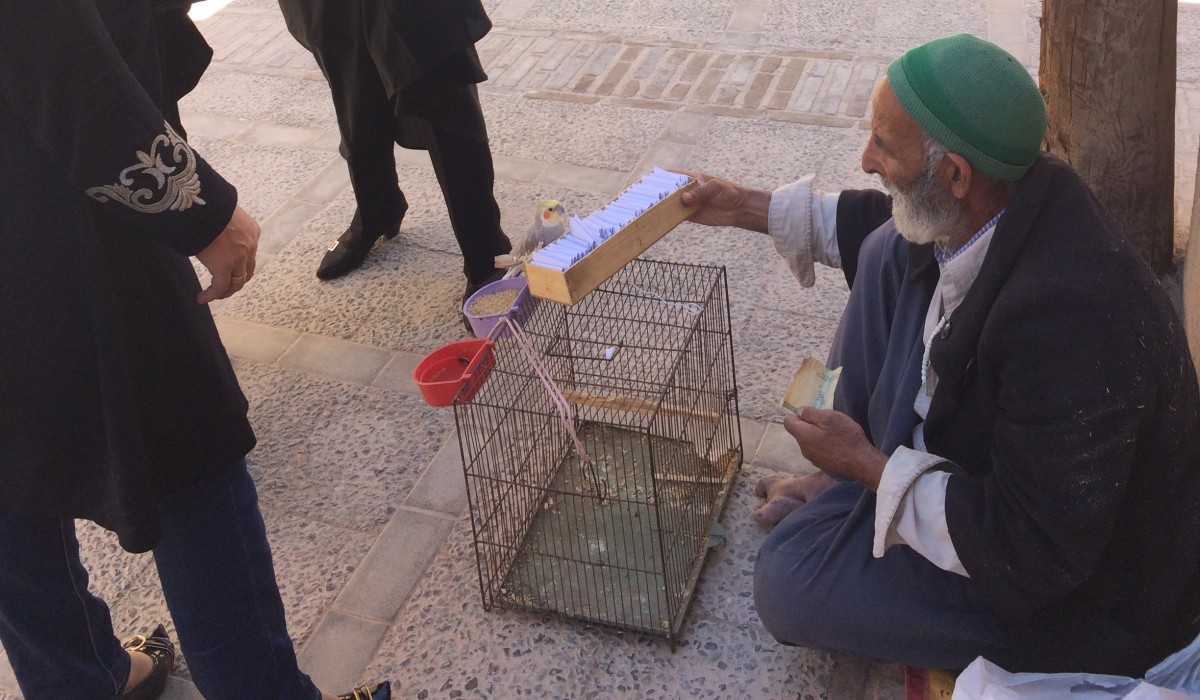
Yazd fortune teller. Photo by Chiara Ferroni.
Let not the pious judge the meek;
Each for his own deeds will speak.
Whether I’m good or bad, you judge yourself;
You reap what you sow, find what you seek.
Everyone is seeking love, sober or drunk;
Everywhere a house of love, yet so unique.
I submit my head on the tavern’s bricks,
If you don’t understand, just take a peek.
Let me keep my hope of eternal grace,
Behind the veil, who is good, who the freak?
Not only I fell out of virtuous path,
My father too, treaded that path oblique.
Hafiz, on your deathbed, bring the cup to your cheek.
You go from the tavern straight to the heaven’s peak.
[Hafez, Ghazal 80]
A Final Reflection on Iran
Lyrical, that is how I would now describe Iran, if I could ignore the brutality reserved for my fellow human rights researchers and so many others. And yet I was captured by the elusiveness of pastel landscapes, the intricate tiling of ornate mosques, a grandfather teaching his granddaughter to ride a bike between the fountains and flowers in Isfahan’s main square, a bored security guard smoking outside a government building in Shiraz, the reassuring bustle of the capital, a tech start-up advertised in English in Yazd, our fate set in verse and revealed by an old man’s parrot. Had I become the quintessential European traveller to the Orient?
The question made me wonder what others had written about Iran, and I stumbled across Montesquieu’s 1721 classic Lettres persanes in which I rediscovered many of the universal questions about what we choose to see when travelling. The tension between looking at the world for what it is, while at the same time scrutinising it for what we want to see is a well-rehearsed trope in travel literature.
In Persian Letters, an epistolary novel tracing the fictional journey and social commentary of a nobleman from Isfahan and his young friend Rica in Eighteenth century Paris, Montesquieu plays with these discrepancies. The protagonist Usbek is the master of a serraglio, a figure of standing in his private and public lives, who owes his urge to travel to a deep sense of curiosity tempered by a degree of prejudice. In France he mingles with the upper echelons and keeps company with equals while maintaining his distinctive Persian, patriarchal and elitist identities. His companion Rica, on the other hand, is subject to fewer social constraints at home and embraces Parisian life and French conventions. He distances himself from his heritage to experience Paris to the full, like the locals, but when novelties become incomprehensible he seeks refuge in the certainties of his past. So in many respects, both travellers experience Paris, the new world, for what it is while at the same time carrying the cultural baggage of their home environment and Persian social norms sometimes lightly, other times more self-consciously. As the plot unfolds, letter after letter, the reader keeps asking herself whether the fictional Usbek and Rica – and perhaps Montesquieu himself – can see Paris in front of them from any perspective other than their own.
My reflections of the trip to Iran are just fragments. Much like Montesquieu’s fictional Persians in France, I too travelled carrying my own baggage, and my recollections of the journey reflect my perspective perhaps more than the complex reality of what I saw. Can twelve nights in Iran help undo the effects of decades of misrepresentation and suspicion that blur the vision of a western eye, that add to centuries of romantic Orientalism? Montesquieu’s young Rica was not impressed with some of the self-assured enlightened Europeans who seemed to know everything about everything, without questioning their own perspective and preconceptions. His admonishment remains timely as we enter into a new phase of European-Iranian relations.
The frustrations of Montesquieu’s fictional Persian would not be misplaced today. Self-assurance and contempt have defined how numerous Western powers have dealt with Iran since the 1979 revolution that deposed the Shah. Sanctions have been a regular feature of US foreign policy in Iran and its allies for nearly 40 years, starting from the hostage crisis in which Iran requested the extradition of the Shah from New York in exchange for the release of the American Embassy personnel.
Since the heights of the Cold War the succession of embargoes against Iran have adapted to the changing times, each wave affecting the population while political cadres accumulated their wealth. The crippling effects on the economy, as well as the human cost of the sanctions, including healthcare provision, remain an underreported reality of these years. Yet Iran’s beauty has not faded, and the warmth and hospitality of its people have survived a relentless succession of internal and international adversities. I left wondering what the future has in store for the country and its people. Perhaps I should have asked the poet Hafez for an answer, by handing over my spare change to that old man and his parrot sitting on a dusty street corner with his smartphone beside him.
Top 7 for a trip to Iran:
Hafez, Divan-e-Hafez (14th century)
Montesquieu, Persian Letters (1721)
Iraj Pezeshkzad, My dear uncle Napoleon (1973)
Edward Said, Orientalism (1978)
Tzvetan Todorov, The Conquest of America (1982)
Marjane Satrapi, Persepolis (2000)
Shirin Ebadi, Iran Awakening (2006)
All photos by Sophia Insoll and her travel companions.

